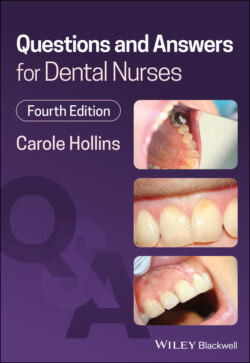Читать книгу Questions and Answers for Dental Nurses - Carole Hollins - Страница 9
Extended matching questions
ОглавлениеThis style of question consists of a given topic heading (such as microbiology, disease prevention, pain and anxiety control and so on) accompanied by a lead‐in statement and a list of options. Each option list is followed by a set of questions that each describe a particular scenario, for which the candidate must choose one or more matching options from the list as the answer(s) to the specific question. All candidates have the same definitive option lists provided in the written examination paper for each question set and can only match answers for each question from the relevant option list. All this style of question follows the form shown below.
The topic covered by the question set is stated, to help focus the candidate’s thought processes.
The lead‐in statement explains what candidates are required to do and how many options they are required to choose from the list – this will either be ‘the single most appropriate…’ or ‘the requested number of…’.
The option list will usually contain a minimum of eight options.
The options are always homologous – of the same form (so all surgical instruments, all restorative materials and so on).
The options are always set out alphabetically or numerically in ascending order (so from a) to b) or from lowest to highest number).
The questions are set out as several sentences that describe a detailed scenario.
They are designed to test the candidate’s analytical and reasoning skills, as well as requiring a more detailed and concise application of their knowledge.
Key words or phrases are not highlighted.
Each topical option list is accompanied by a question set, rather than a single question.
The candidates must read the lead‐in statement carefully for each question set, as this gives the information required to match an answer to each question correctly. So, are they matching an appropriate emergency drug to a medical emergency scenario, or an appropriate oral hygiene item to an oral health assessment scenario, or an appropriate instrument to set out for a restorative procedure and so on. Also, the lead‐in statement will state whether just one or more than one answer may be required for questions within that set – obviously if the wrong number is given by the candidate, the answer will be rejected. Where multiple matched answers are to be given, each question will state the number required.
Again, the alphabetical or numerical order of the option list will prevent the candidates from attempting to guess a likely answer by believing, for example, that option e) has not been used previously and so choose it. The lead‐in statement for EMQs will always state that ‘each option might be used once, more than once or not at all’. Candidates are required to mark their answers as a pencilled horizontal line on an optical marking sheet, as detailed above in the section on MCQs.
With EMQs, candidates are required to first understand the question scenario as it is described, then apply detailed knowledge of the topic to the scenario so that they can reason out and match the answer(s) from the option list.
Below are several examples of extended matching questions and answers showing the various formats discussed.
